
The SharePoint Proposal: Understanding the Technical Limitations
Executive Summary: While SharePoint is widely used by enterprises and appears in technology surveys across many organizations, its technical architecture makes it poorly suited for modern public-facing websites. This analysis examines the technical limitations that lead organizations to choose specialized CMS platforms like Drupal and Adobe Experience Manager for their public digital presence, even when SharePoint is deployed internally.
Table of Contents
- The SharePoint Proposal Story
- Understanding SharePoint's Market Presence
- The Complexity of Enterprise Web Architectures
- Verified Examples of Public Website Technology
- SharePoint's Genuine Strengths
- 10 Technical Limitations for Public Websites
- Specialized CMS Platforms for Public Websites
- Common Enterprise Architecture Patterns
- Organizations Using SharePoint Publicly
- Technical Decision Framework
- Frequently Asked Questions
The SharePoint Proposal Story
It started with what seemed like a logical proposal in a technology strategy meeting. A colleague, let's call him Marcus, confidently suggested: "Why are we considering separate CMS platforms for our public website when we're already invested in Microsoft SharePoint? We have the licenses, our teams know the platform, and it has extensive features for content management."
On paper, it sounded efficient. The licensing costs were already covered. Teams were trained. Integration with Microsoft 365 was seamless. Why introduce another system?
This scenario plays out in organizations worldwide. SharePoint's ubiquity in enterprises—it appears in market surveys showing 100% presence among certain sectors—creates an assumption that it's suitable for all content management needs. However, this assumption overlooks fundamental technical architecture differences between internal collaboration platforms and public-facing digital experience platforms.
This article examines the technical reasons why SharePoint, despite its strengths for internal operations, has critical limitations for public websites.
Understanding SharePoint's Market Presence
The WhatCMS Data: Interpreting 100% Market Share
According to WhatCMS.org data analyzing government and institutional websites, SharePoint appears to have 100% market share (6,216 domains) in certain sectors, significantly ahead of WordPress (17.68%), Drupal (8.51%), and Adobe Experience Manager (2.25%).
Critical Context: This data requires careful interpretation:
- Internal vs. External Use: Most organizations in the survey likely use Microsoft 365, which includes SharePoint. The survey may be detecting SharePoint's internal presence, not public website deployment.
- Subdomain Detection: Many organizations have SharePoint-powered intranets on subdomains (e.g., intranet.organization.org) that may be detected by crawlers.
- Mixed Environments: Large organizations often run multiple platforms simultaneously—SharePoint internally and specialized CMS platforms for public sites.
- Authentication Gates: SharePoint installations behind authentication may register differently than public-facing content management systems.
The Reality: While SharePoint has enormous enterprise presence for internal operations, its use for primary public-facing websites is far less common than the raw data suggests.
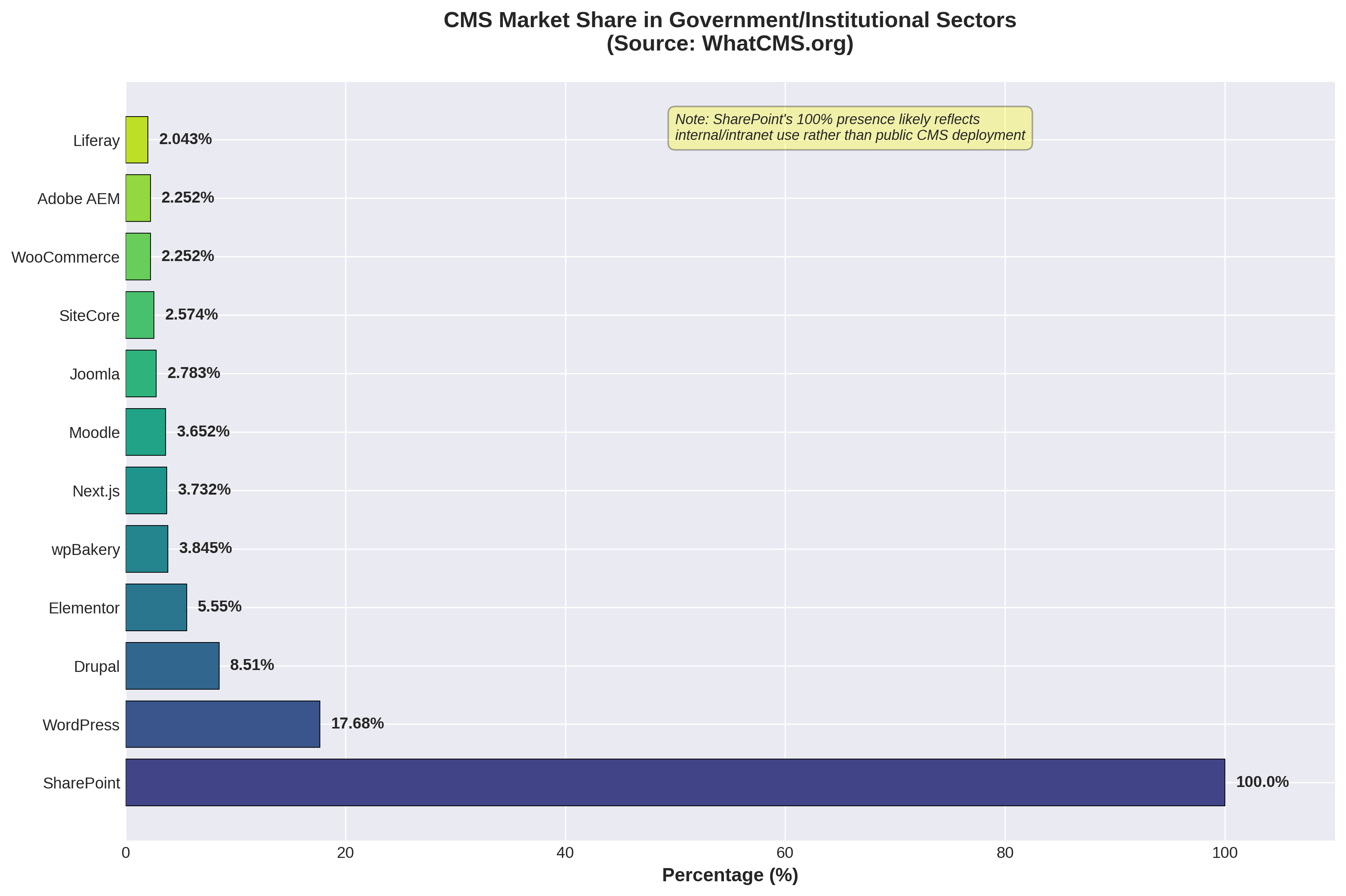
Figure 1: CMS Market Share in Government/Institutional Sectors. SharePoint's 100% presence likely reflects internal/intranet usage rather than public CMS deployment. Source: WhatCMS.org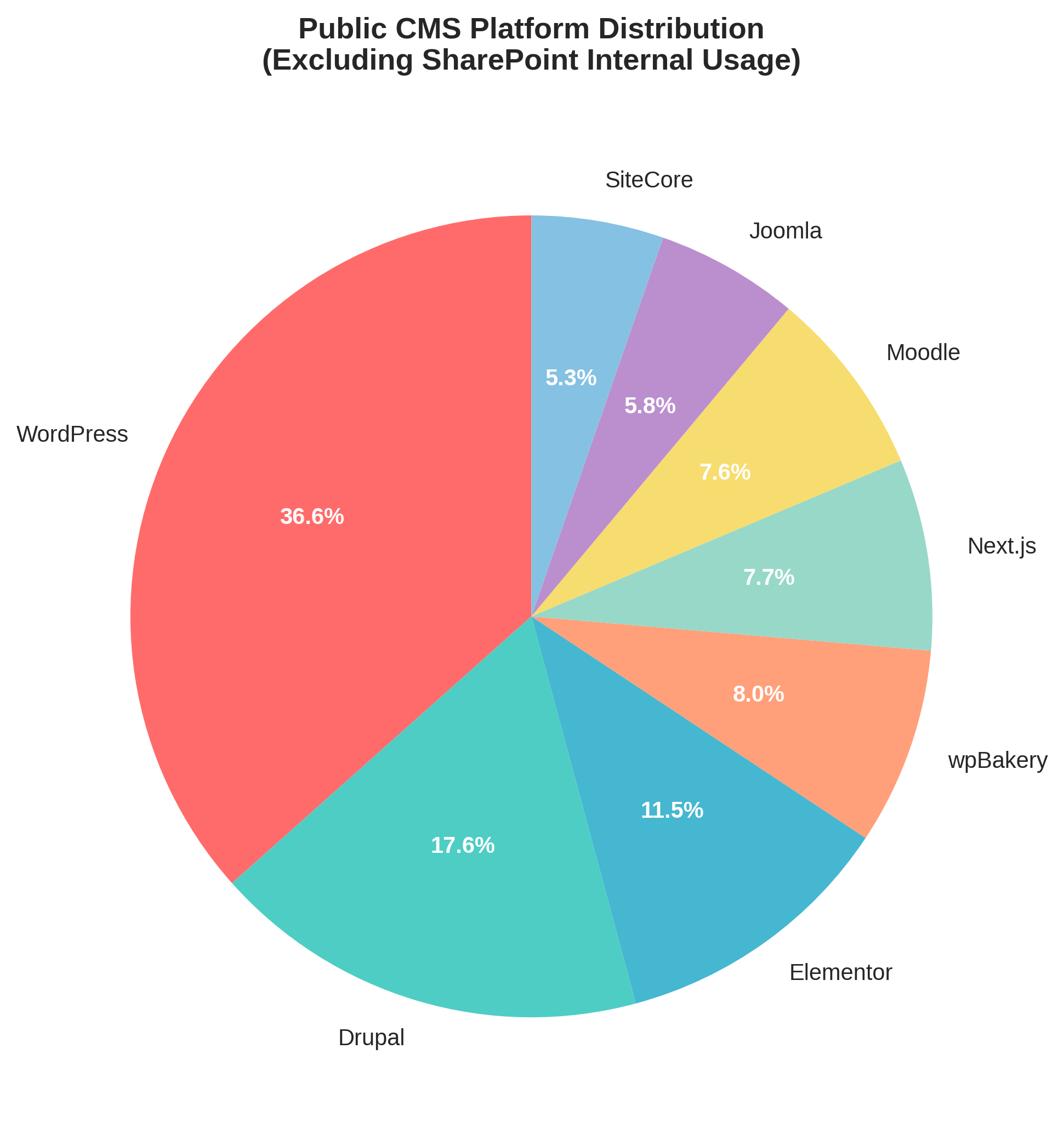 Figure 2: When excluding SharePoint's internal presence, WordPress, Drupal, and specialized enterprise CMS platforms dominate public website deployment.
Figure 2: When excluding SharePoint's internal presence, WordPress, Drupal, and specialized enterprise CMS platforms dominate public website deployment.
The Complexity of Enterprise Web Architectures
Multiple Platforms, Multiple Purposes
Large institutions rarely use a single platform for all digital needs. Instead, they employ sophisticated multi-platform architectures where different systems serve different purposes:
Typical Enterprise Digital Architecture
- Main Public Website: Purpose-built CMS (Drupal, Adobe AEM, Sitecore)
- Intranet/Staff Portal: SharePoint or similar collaboration platform
- Specialized Portals: Domain-specific platforms (e.g., data portals, project databases)
- Microsites/Campaigns: May use different platforms based on specific needs
- Legacy Systems: Older sites not yet migrated to current architecture
The Migration Reality
Enterprise web architectures evolve continuously. Organizations frequently:
- Migrate primary websites to modern platforms while maintaining legacy subsystems
- Run multiple CMS platforms simultaneously during multi-year transitions
- Maintain older Drupal versions on subdomains while main sites use newer platforms
- Keep specialized systems on different platforms based on specific requirements
Important Note: When analyzing any organization's technology stack, you're often seeing a snapshot of an ongoing evolution, not a single monolithic architecture.
Verified Examples of Public Website Technology
World Bank Group: Multi-Platform Architecture
Primary Website: worldbank.org uses Adobe Experience Manager (though exact migration date is not publicly documented)
Drupal-Powered Subsites (Verified):
- alerts.worldbank.org: Drupal 9
- climateknowledgeportal.worldbank.org: Drupal 11
- esmap.org: Drupal
- lpi.worldbank.org: Drupal 9
- ppp.worldbank.org: Drupal 10
What This Tells Us: The World Bank runs a sophisticated multi-platform digital ecosystem. While the main corporate site uses Adobe AEM, numerous specialized portals and knowledge platforms use Drupal in various versions. This demonstrates:
- Large organizations use different platforms for different purposes
- Migration is phased and ongoing—not all subsites move to the primary platform simultaneously
- Legacy Drupal installations may persist while main sites use newer platforms
- Specialized content (climate data, logistics performance, public-private partnerships) may warrant dedicated platforms
United Nations: Long-Standing Drupal Deployment
un.org: Uses Drupal 7 (as verified)
Significance: Despite Drupal 7 reaching end-of-life, major international organizations often maintain stable systems that work, planning migrations carefully rather than rushing updates. This illustrates real-world enterprise decision-making around platform longevity and risk management.
Organizations Using SharePoint for Public Websites
SharePoint is used by some organizations for public-facing websites. Verified examples include:
- lww.com: Lippincott Williams & Wilkins (medical publisher)
- healthychildren.org: American Academy of Pediatrics
- homeaffairs.gov.au: Australian Government Department of Home Affairs
Important Context: These implementations exist and function. However, they typically represent:
- Legacy decisions from when SharePoint public website features were actively supported
- Specific organizational constraints or requirements that made SharePoint the chosen solution
- Heavy customization and development to overcome SharePoint's public website limitations
- Organizations deeply committed to Microsoft ecosystem integration
The existence of these implementations doesn't negate SharePoint's technical limitations for public websites—rather, it demonstrates that organizations will implement what they need with available tools, even when those tools aren't optimal for the purpose.
SharePoint's Genuine Strengths
Before examining limitations, it's essential to acknowledge what SharePoint does exceptionally well:
1. Internal Document Management and Collaboration
SharePoint excels at:
- Structured document libraries with version control
- Collaborative document authoring and review workflows
- Permissions-based access to sensitive information
- Integration with Microsoft Office applications
- Audit trails and compliance features
2. Microsoft Ecosystem Integration
- Seamless integration with Outlook, Teams, OneDrive
- Azure Active Directory authentication
- Power Platform integration (Power Automate, Power Apps)
- Microsoft 365 Groups integration
3. Enterprise Collaboration Features
- Team sites for departments and projects
- Intranet portal capabilities
- Task management and workflows
- Business intelligence dashboards
4. Enterprise-Grade Security and Compliance
- Robust permission systems
- Data loss prevention (DLP)
- Compliance center integration
- eDiscovery capabilities
These strengths explain SharePoint's widespread adoption for internal operations. The challenge arises when organizations attempt to extend these internal capabilities to public-facing websites, where the technical requirements are fundamentally different.
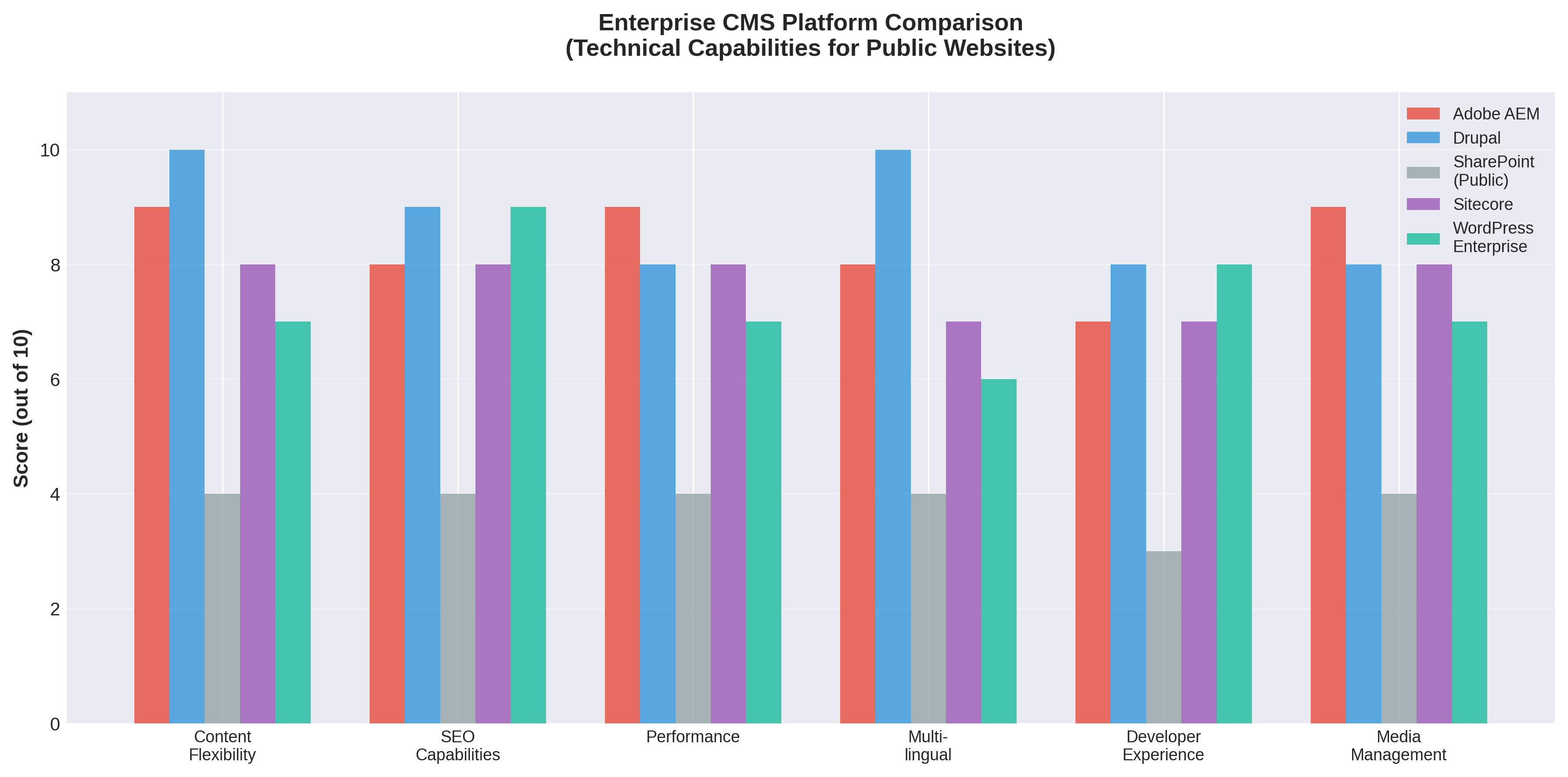 Figure 3: Enterprise CMS Platform Comparison for Public Websites. SharePoint scores significantly lower than purpose-built CMS platforms across all public website requirements.
Figure 3: Enterprise CMS Platform Comparison for Public Websites. SharePoint scores significantly lower than purpose-built CMS platforms across all public website requirements.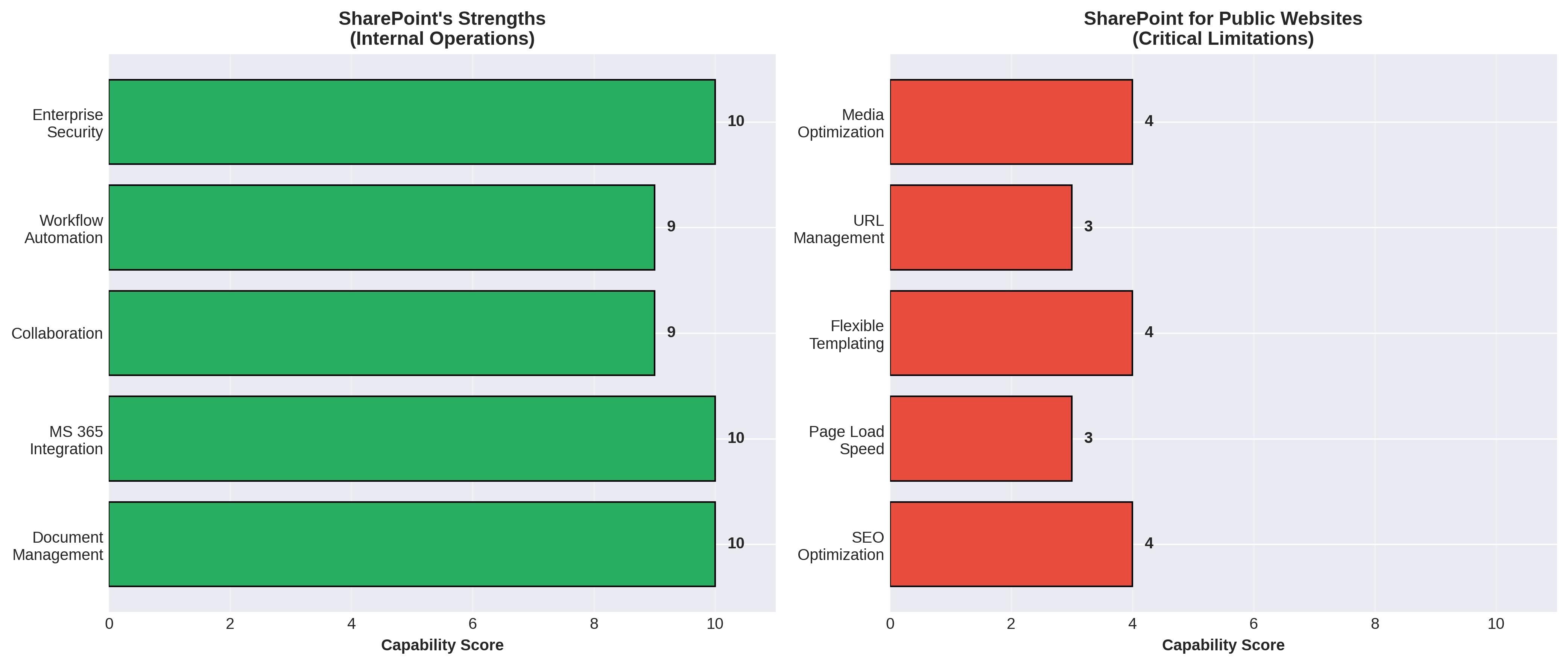 Figure 4: SharePoint excels at internal operations (left) but has critical limitations for public websites (right). The platform's architecture is optimized for the wrong use case.
Figure 4: SharePoint excels at internal operations (left) but has critical limitations for public websites (right). The platform's architecture is optimized for the wrong use case.
10 Technical Limitations of SharePoint for Public Websites
The following limitations are based on SharePoint's technical architecture and documented features:
1. Content Type System: Built for Documents, Not Digital Experiences
The Technical Issue: SharePoint's content type system was architected for structured business documents and list-based data, not the diverse content types required for modern web experiences.
Specific Technical Limitations:
- List-Based Architecture: SharePoint's foundation is document libraries and lists. While these work for structured data, they're limiting for complex web content with multiple relationships.
- Content Type Creation Complexity: Creating custom content types requires SharePoint development expertise, Visual Studio, and deployment through solution packages. In Drupal, content types are created through the UI in minutes.
- Limited Relationship Modeling: Representing complex relationships (e.g., a development project linked to multiple countries, sectors, funding sources, outcomes, and related documents) requires extensive custom development.
- Media Handling: No native support for:
- Automatic responsive image variant generation
- Focal point selection for cropping
- Modern image formats (WebP, AVIF)
- Video transcoding or streaming optimization
Real-World Impact: Publishing rich multimedia content with complex relationships—standard practice in modern CMS platforms—requires significant custom development in SharePoint.
2. Page Rendering: Master Pages vs. Modern Component Architecture
The Technical Issue: SharePoint's page rendering model dates from ASP.NET Web Forms era, incompatible with modern component-based web development.
Specific Technical Limitations:
- Master Page System: Rigid, server-side rendered master pages limit design flexibility compared to modern template engines (Twig, React, Vue)
- ViewState and PostBack Model: Server-side state management creates heavy pages unsuitable for modern web performance
- Web Parts vs. Modern Components: SharePoint web parts don't provide the composability and reusability of modern component systems
- CSS/JavaScript Conflicts: SharePoint's own CSS and JavaScript often conflict with custom styling, requiring extensive overrides
- Limited Responsive Capabilities: While modern SharePoint has improved, achieving truly responsive designs requires fighting the framework
3. URL Structure: Internal Logic vs. SEO Requirements
The Technical Issue: SharePoint generates URLs based on internal site structure and list architecture, not SEO-friendly patterns.
Specific Technical Limitations:
- URL Pattern Example:
- SharePoint:
/sites/PublicWeb/Pages/Forms/AllItems.aspx?RootFolder=%2Fsites%2FPublicWeb%2FPages%2FEN%2FProjects - Modern CMS:
/projects/clean-water-kenya
- SharePoint:
- URL Rewriting Complexity: Implementing clean URLs requires:
- Custom HTTP modules
- IIS URL Rewrite rules
- Ongoing maintenance as SharePoint structure changes
Metadata Injection Challenges: Adding proper:
- Open Graph tags for social sharing
- Schema.org structured data
- Custom meta descriptions
...requires custom master pages or JavaScript injection
- XML Sitemap Generation: Not native; requires third-party solutions
4. Performance Architecture: Internal Networks vs. Global Public Access
The Technical Issue: SharePoint was optimized for authenticated users on corporate networks, not anonymous high-traffic public access.
Specific Technical Limitations:
- Page Weight: SharePoint pages typically load 2-3MB of JavaScript and CSS before displaying content. Modern public websites target <500KB initial loads.
- Server-Side Rendering Overhead: ViewState, server controls, and PostBack model create processing overhead
- Caching Complexity: Effective anonymous caching requires:
- Blob cache configuration
- Output cache profiles
- Custom cache control headers
- Often third-party caching layers
- CDN Integration: While possible, SharePoint's asset management doesn't natively optimize for CDN delivery
- Database Chattiness: SharePoint makes numerous database calls per page render, impacting scalability
Performance Impact: Organizations needing sub-2-second page loads globally require extensive infrastructure and optimization work beyond SharePoint's default architecture.
5. SEO Capabilities: Enterprise Intranet vs. Search Engine Optimization
The Technical Issue: SharePoint wasn't designed with public search engine optimization as a priority.
Specific Technical Limitations:
- Meta Tag Management: No user-friendly interface for managing SEO meta tags per page
- Structured Data: No native support for Schema.org JSON-LD markup
- Canonical URLs: Require manual configuration and management
- XML Sitemaps: Third-party solutions needed
- robots.txt Management: Limited control compared to modern CMS platforms
- Social Sharing: Open Graph and Twitter Card metadata require custom implementation
- Page Speed: Core Web Vitals optimization difficult due to architectural constraints
6. Multilingual Architecture: Variations vs. Translation Management
The Technical Issue: SharePoint's variation system for multilingual sites is notoriously complex and difficult to maintain.
Specific Technical Limitations:
- Variations Configuration: Complex setup requiring:
- Variation hierarchy definition
- Variation label configuration
- Publishing schedule management
- Often breaks with updates
- No Translation Workflow: Unlike modern CMS platforms with built-in translation workflows, SharePoint requires manual coordination
- Language Fallback: Unpredictable behavior when content isn't available in user's language
- RTL Language Support: Requires extensive custom CSS for Arabic, Hebrew, etc.
- Translator Experience: No dedicated translation interface; translators work with same complex interface as developers
7. Digital Asset Management: Document Storage vs. Modern DAM
The Technical Issue: SharePoint's asset libraries are designed for document storage, not the sophisticated digital asset management modern websites require.
Specific Technical Limitations:
- No Automatic Image Processing: Modern CMS platforms auto-generate multiple sizes; SharePoint doesn't
- No Focal Point Selection: Can't specify crop focus for different aspect ratios
- Limited Metadata: Basic metadata capabilities compared to dedicated DAM systems
- Video Management: No native transcoding, adaptive bitrate streaming, or thumbnail generation
- Asset Search: Basic search functionality compared to AI-powered asset discovery in modern platforms
8. Data Presentation: List Views vs. Dynamic Content Display
The Technical Issue: SharePoint's list views and data presentation are designed for internal business users, not engaging public experiences.
Specific Technical Limitations:
- Query Performance: Complex filtered views (e.g., "show all projects in East Africa with budgets >$10M, sorted by impact metrics") struggle at scale
- No Faceted Search: Modern faceted filtering (filter by multiple criteria simultaneously with live count updates) requires custom development
- Visualization Limitations: Creating maps, charts, and interactive dashboards requires:
- Custom web parts
- Third-party visualization libraries
- Extensive JavaScript development
- List View Threshold: 5,000-item limit creates challenges for large datasets
9. Development Workflow: Server-Based vs. Modern DevOps
The Technical Issue: SharePoint's development model predates modern DevOps practices.
Specific Technical Limitations:
- No Version Control Integration: SharePoint solutions don't naturally fit Git workflows
- Limited Local Development: Can't easily run full SharePoint environment locally; most development happens on development servers
- No CI/CD Pipeline Support: While SharePoint Framework (SPFx) has improved this, traditional SharePoint customization doesn't fit modern deployment pipelines
- Testing Challenges: Automated testing of SharePoint customizations is difficult
- Deployment Risk: Manual deployments to production are risky compared to automated, tested deployments
10. Total Cost of Ownership: "Free" Licensing vs. Reality
The Misconception: "We already pay for SharePoint, so using it for our public website is free."
The Reality:
| Cost Factor | SharePoint Approach | Purpose-Built CMS |
|---|---|---|
| Licensing | $0 (already owned) | $50K-$200K |
| Custom Development | $500K-$2M | $200K-$800K |
| Annual Maintenance | $200K-$500K | $100K-$200K |
| Infrastructure (5 years) | $300K-$600K | $200K-$400K |
| 5-Year TCO | $2M-$4.5M | $1.5M-$2.8M |
| Outcome Quality | Mediocre-Adequate | Excellent |
Why SharePoint Costs More:
- Every limitation requires custom development to overcome
- SharePoint customizations often break with updates
- Requires specialized SharePoint developers (expensive, hard to find)
- Performance infrastructure to make SharePoint work for public access
- Opportunity cost: time fighting SharePoint instead of building features
 Figure 5: 5-Year Total Cost of Ownership. Despite "free" licensing, SharePoint for public websites costs nearly 2x more than purpose-built CMS platforms due to extensive custom development and maintenance requirements.
Figure 5: 5-Year Total Cost of Ownership. Despite "free" licensing, SharePoint for public websites costs nearly 2x more than purpose-built CMS platforms due to extensive custom development and maintenance requirements.
Microsoft's Official Position: Deprecated Public Website Features
Critical Fact: In March 2015, Microsoft officially announced discontinuation of SharePoint Online's public website feature.
"As part of the evolution of the Office 365 service, we periodically evaluate the capabilities of the service to make sure that we're delivering the utmost value to customers. After careful consideration, we concluded that for public websites, Office 365 customers would be better served by third-party providers whose core competency is public websites."
— Microsoft Documentation, March 9, 2015
What This Means: Microsoft itself acknowledges that SharePoint is not the optimal platform for public websites. They recommend third-party CMS providers whose "core competency is public websites."
This isn't an opinion or competitive criticism—it's Microsoft's official guidance to its own customers.
Specialized CMS Platforms for Public Websites
The following platforms are purpose-built for public-facing digital experiences:
Enterprise-Grade Platforms
Adobe Experience Manager (AEM)
- Strengths: Enterprise-scale content management, sophisticated personalization, robust digital asset management, multi-site management
- Best For: Large organizations needing content orchestration across multiple brands, regions, and channels
- Technical Advantages: Component-based architecture, headless capabilities, integrated DAM, marketing cloud integration
- Licensing: High-end enterprise pricing
Sitecore
- Strengths: Marketing automation integration, personalization engine, analytics, multi-channel delivery
- Best For: Marketing-focused organizations prioritizing personalization and customer journey orchestration
- Technical Advantages: .NET-based (familiar to Microsoft shops), strong personalization, marketing automation
- Licensing: Enterprise pricing
Open Source Enterprise Platforms
Drupal (Enterprise Distributions)
- Strengths: Extremely flexible content modeling, excellent multilingual support, strong security track record, large active community
- Best For: Organizations needing custom content types, complex workflows, and flexibility
- Technical Advantages: Modular architecture, extensive API, strong taxonomy system, excellent accessibility
- Licensing: Open source (free); enterprise distributions like Acquia provide support and additional features
- Notable Users: Many government agencies, international organizations, universities
WordPress VIP / Enterprise
- Strengths: User-friendly, massive ecosystem, excellent for content publishing, fast time-to-market
- Best For: Organizations prioritizing editor experience and content velocity
- Technical Advantages: Intuitive interface, extensive plugin ecosystem, strong community
- Licensing: Open source (free); VIP and enterprise hosting provides enterprise support
- Notable Users: News organizations, content-heavy sites, marketing-focused sites
Headless/Composable CMS Platforms
Contentful
- Strengths: API-first architecture, flexible content modeling, multi-channel delivery
- Best For: Organizations wanting to decouple content from presentation, deliver to multiple channels
- Technical Advantages: GraphQL/REST APIs, modern developer experience, cloud-native
Strapi
- Strengths: Open source headless CMS, customizable, self-hostable or cloud
- Best For: Organizations wanting flexibility and control
- Technical Advantages: Node.js-based, plugin system, auto-generated APIs
Common Enterprise Architecture Patterns
Based on observable patterns in large organizations:
Pattern 1: The Two-Platform Strategy
Most Common Approach:
- Internal Operations: SharePoint or similar collaboration platform
- Document management and version control
- Team sites and project workspaces
- Workflow automation
- Integration with productivity tools
- Public Digital Experience: Purpose-built CMS
- Public website content management
- SEO optimization
- Performance optimization
- Multi-channel delivery
Integration Points:
- Single Sign-On (SSO) for staff accessing both systems
- APIs for content publishing workflows
- Data feeds from internal systems to public portals
- Selective document publication from internal repositories to public access
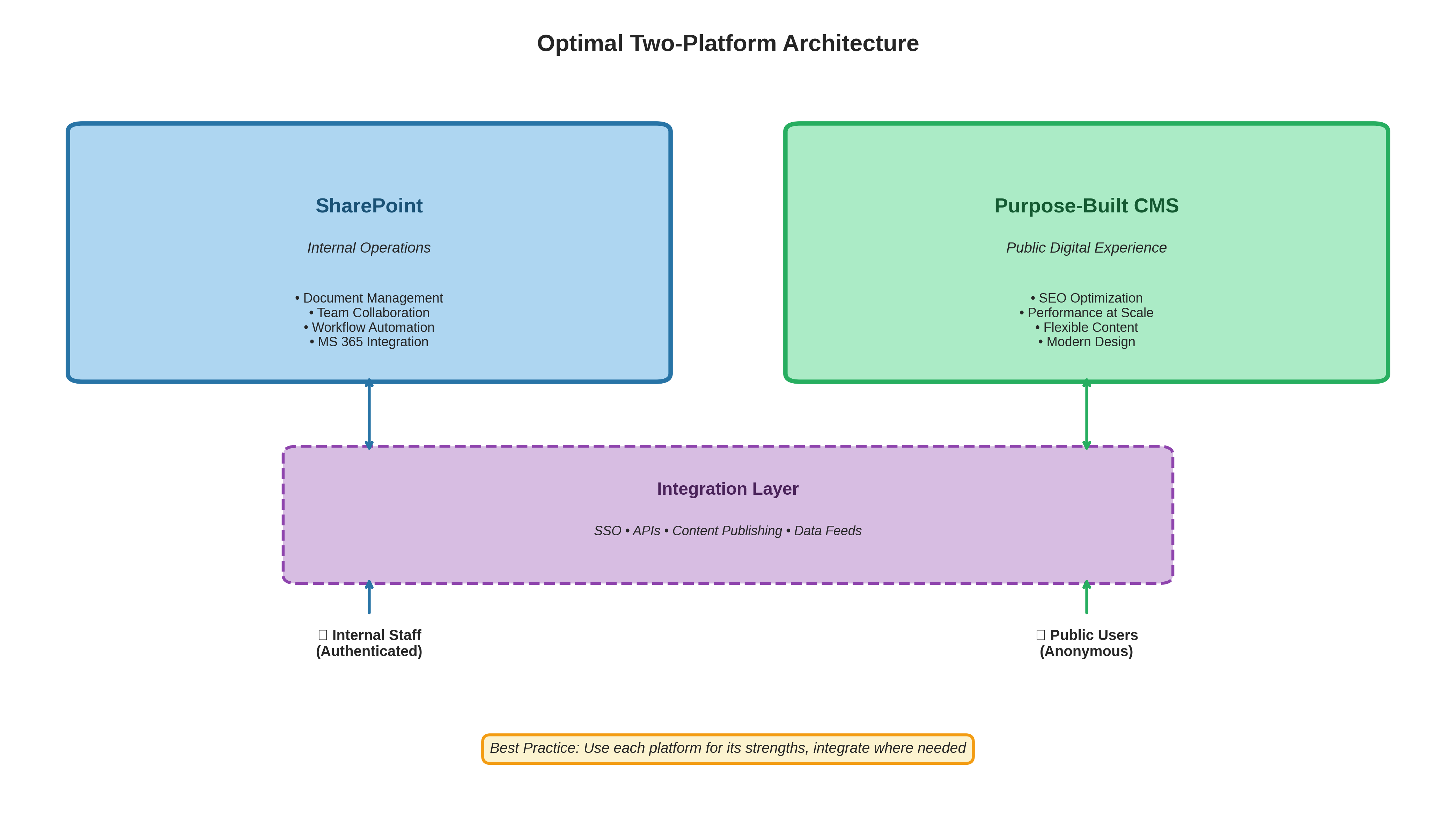 Figure 6: Optimal Two-Platform Architecture. Organizations use SharePoint for internal strengths and purpose-built CMS for public needs, integrating through SSO, APIs, and content publishing workflows.
Figure 6: Optimal Two-Platform Architecture. Organizations use SharePoint for internal strengths and purpose-built CMS for public needs, integrating through SSO, APIs, and content publishing workflows.
Pattern 2: Multi-Platform Ecosystem
Complex Organizations:
- Main Corporate Site: Enterprise CMS (AEM, Drupal)
- Specialized Portals: Domain-specific platforms
- Data portals (custom applications)
- Knowledge bases (specialized documentation platforms)
- Project databases (custom or specialized CMS)
- Legacy Subsites: Older platforms being phased out
- Intranet: SharePoint or similar
- Collaboration Tools: Microsoft 365, Slack, etc.
Pattern 3: Phased Migration
Observable in Large Organizations:
- Phase 1: Migrate main corporate website to modern CMS
- Phase 2: Migrate high-traffic subsites and key content
- Phase 3: Migrate specialized portals (often taking years)
- Ongoing: Legacy systems persist indefinitely if still functional
This explains why organizations like World Bank have Adobe AEM for their main site but still maintain Drupal 9, 10, and 11 installations across various subsites.
 Figure 7: Typical Enterprise CMS Migration Timeline. Large organizations migrate in phases over years, explaining why multiple CMS versions and platforms coexist. Legacy systems persist if still functional.
Figure 7: Typical Enterprise CMS Migration Timeline. Large organizations migrate in phases over years, explaining why multiple CMS versions and platforms coexist. Legacy systems persist if still functional.
When SharePoint Is Used for Public Websites
As verified, some organizations do use SharePoint for public websites. Understanding why helps contextualize the decision:
Scenarios Where SharePoint Public Deployment Occurs
- Legacy Decisions: Sites implemented before Microsoft deprecated public website features (pre-2015)
- Deep Microsoft Ecosystem Commitment: Organizations heavily invested in Microsoft stack willing to accept trade-offs
- Specific Requirements: Unique organizational needs where SharePoint features outweigh limitations
- Budget Constraints: Perception of "free" licensing overriding TCO analysis
- Limited Public Traffic: Low-traffic sites where performance isn't critical
- Heavy Customization Budget: Organizations with resources for extensive custom development
Common Characteristics of SharePoint Public Implementations
- Extensive custom development to overcome platform limitations
- Dedicated SharePoint development teams
- Lower traffic expectations than typical modern public sites
- Strong authentication/security requirements that align with SharePoint's strengths
- Content types primarily document-based rather than diverse media
Important: These implementations work for their specific contexts. However, they don't negate SharePoint's technical limitations—they represent organizations working within those constraints.
Technical Decision Framework
When evaluating SharePoint for public websites, assess these technical requirements:
Assessment Questions
- Content Diversity: Will you publish more than documents? (Yes = challenge for SharePoint)
- Traffic Volume: Expect >10,000 anonymous daily visitors? (Yes = challenge for SharePoint)
- Performance Requirements: Need <2-second mobile page loads? (Yes = challenge for SharePoint)
- SEO Criticality: Is organic search traffic critical? (Yes = challenge for SharePoint)
- Design Requirements: Need pixel-perfect brand implementation? (Yes = challenge for SharePoint)
- Multilingual Needs: Publishing in 3+ languages with translation workflows? (Yes = challenge for SharePoint)
- Content Relationships: Need complex content relationships and taxonomies? (Yes = challenge for SharePoint)
- Media Richness: Publishing photos, videos, interactive content regularly? (Yes = challenge for SharePoint)
- Development Practices: Want modern Git-based DevOps workflows? (Yes = challenge for SharePoint)
- Development Budget: Can afford extensive custom development and ongoing maintenance? (No = problem for SharePoint)
Scoring
- 0-3 challenges: SharePoint might be viable (though still not optimal)
- 4-6 challenges: SharePoint will require significant custom development and compromise
- 7+ challenges: SharePoint is technically unsuitable; use purpose-built CMS
Frequently Asked Questions
Is the WhatCMS data showing SharePoint really for public websites?
The 100% SharePoint market share in certain surveys likely reflects SharePoint's internal presence rather than public website deployment. Most organizations use Microsoft 365 (which includes SharePoint) for internal operations. Surveys detecting SharePoint may be identifying internal installations, authentication-gated intranets, or subdomains rather than primary public websites. The data requires contextual interpretation.
Why did Microsoft discontinue SharePoint public website features?
In March 2015, Microsoft stated: "After careful consideration, we concluded that for public websites, Office 365 customers would be better served by third-party providers whose core competency is public websites." Microsoft recognized that maintaining competitive public website features wasn't their strategic focus, and third-party CMS providers offered better solutions.
Can't SharePoint be customized to overcome its limitations?
Yes, with sufficient development resources, SharePoint can be heavily customized. However, this approach typically costs 2-3x more than implementing a purpose-built CMS over 5 years, while still delivering inferior results. Every limitation requires custom development, ongoing maintenance, and often breaks with SharePoint updates. The "free" licensing becomes very expensive in total cost of ownership.
What CMS platforms do major organizations actually use for public websites?
Based on verified examples: World Bank Group uses Adobe Experience Manager (main site) and Drupal (multiple specialized portals); United Nations uses Drupal 7; many government agencies use Drupal; private sector organizations use various platforms including Adobe AEM, Sitecore, Drupal, and WordPress Enterprise depending on specific needs. The pattern is clear: purpose-built CMS platforms for public sites, with possible SharePoint use for internal operations.
Why do some organizations use SharePoint for public websites if it has limitations?
Organizations use SharePoint publicly for various reasons: legacy decisions from before Microsoft deprecated public features, deep Microsoft ecosystem commitment, specific organizational requirements, perception of "free" licensing, low traffic requirements, or budget for extensive customization. These implementations work in their specific contexts but don't negate SharePoint's technical limitations for public websites.
How do large organizations manage multiple CMS platforms?
Large organizations typically employ different platforms for different purposes: main corporate site on enterprise CMS, specialized portals on domain-specific platforms, intranet on SharePoint, and legacy systems maintained as-needed. Integration occurs through SSO, APIs, and content publishing workflows. This multi-platform approach is standard practice in complex enterprises.
What happens to old subsites during CMS migrations?
Enterprise CMS migrations are phased over years. Main sites migrate first, followed by high-traffic subsites, then specialized portals. Legacy systems often persist indefinitely if still functional and migration cost isn't justified. This explains why organizations run multiple CMS versions simultaneously—it's not poor planning but practical reality of large-scale digital operations.
Conclusion: Technical Architecture Matters
SharePoint is an excellent platform for its designed purpose: internal collaboration, document management, and enterprise workflow automation. Its widespread adoption for these purposes is well-deserved.
However, technical architecture matters. SharePoint's architecture—designed for authenticated internal users on corporate networks—has fundamental limitations for public-facing websites requiring:
- Fast page loads for anonymous users worldwide
- SEO optimization for organic discovery
- Flexible content modeling for diverse media types
- Modern component-based design systems
- Translation management for multilingual content
- Performance at scale for traffic spikes
- Clean URLs and proper metadata
The evidence is clear:
- Microsoft deprecated public website features, recommending specialized providers
- Major organizations use different platforms for internal operations vs. public websites
- Where SharePoint is used publicly, it typically involves extensive customization and compromise
- Purpose-built CMS platforms deliver better results at lower total cost
The optimal architecture separates concerns: SharePoint for what it does best (internal collaboration), specialized CMS platforms for what they do best (public digital experiences).
Choose tools based on technical requirements, not convenience or perception of "free." The right architecture delivers better user experiences, lower total cost, and sustainable long-term operations.
Disclaimer: This analysis is based on publicly available technical information, documented SharePoint features and limitations, verified website technology stacks, and observable industry patterns. Claims about organizational practices represent reasonable inferences from available evidence and industry analysis, not insider knowledge of specific organizational decisions. Microsoft SharePoint is a registered trademark of Microsoft Corporation.
About Simon Adjatan: This article draws on 15+ years of experience implementing enterprise content management systems for international organizations, government agencies, and large enterprises. The author has worked with World Bank Group, regional development banks, and UN agencies on digital transformation initiatives.





